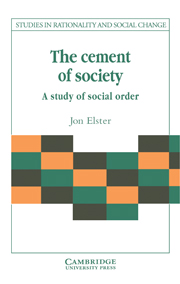Book contents
Conclusion: the cement of society
Published online by Cambridge University Press: 09 January 2010
Summary
Introduction
There are no societies, only individuals who interact with each other. Yet the structure of interaction allows us to identify clusters of individuals who interact more strongly with each other than with people in other clusters. These clusters are hierarchically arranged. Imagine a series of concentric circles or, more generally, of nested closed curves, covering a given territory. For the area enclosed by any given curve, we can calculate – at least in principle – a coefficient of cohesion, defined as the number of transactions between individuals in the area divided by the total number of transactions in which these individuals are involved. As we move up in the hierarchy, from smaller to larger areas, the coefficient will increase, decrease, increase again and so on. In the Roman Empire, the coefficient decreases as we move from the city to the province, increases as we move from the province to the empire and decreases again as we move outside the empire to include the barbarian environment. In the following, the term ‘society’ refers to any area which has a local maximum of cohesiveness, so that any slightly smaller or slightly larger area has a lower coefficient. There is no presumption that a society in this sense is well ordered. The interaction that defines a society can be destructive – the war of all against all – as well as cooperative.
Superimposed upon these hierarchical clusters of interaction are cultural fields. The vehicles of culture are tradition and social norms. As a paradigm of culture we may take language.
- Type
- Chapter
- Information
- The Cement of SocietyA Survey of Social Order, pp. 248 - 287Publisher: Cambridge University PressPrint publication year: 1989
- 4
- Cited by

